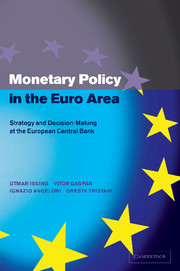Book contents
- Frontmatter
- Contents
- List of figures
- List of tables
- Acknowledgements
- Introduction
- 1 Money, output and prices: the scope of monetary policy
- 2 Monetary policy making: strategies and rules
- 3 The euro area: an overview
- 4 The ECB strategy: defining price stability
- 5 The role of money
- 6 A broadly based assessment
- 7 The ECB strategy: an overall view
- 8 The operational framework
- 9 Accountability and transparency
- 10 The single monetary policy in 1999
- Appendix Excerpts from ECB external communications to the press
- References
- Index
10 - The single monetary policy in 1999
Published online by Cambridge University Press: 22 September 2009
- Frontmatter
- Contents
- List of figures
- List of tables
- Acknowledgements
- Introduction
- 1 Money, output and prices: the scope of monetary policy
- 2 Monetary policy making: strategies and rules
- 3 The euro area: an overview
- 4 The ECB strategy: defining price stability
- 5 The role of money
- 6 A broadly based assessment
- 7 The ECB strategy: an overall view
- 8 The operational framework
- 9 Accountability and transparency
- 10 The single monetary policy in 1999
- Appendix Excerpts from ECB external communications to the press
- References
- Index
Summary
A careful investigation of the evidence and analyses that form the background of actual policy decisions is of crucial importance to understanding in detail the key features of any monetary policy strategy. This exercise is possibly even more important for the strategy of the ECB, since it can show if there is any difference between the strategy actually followed and the one announced. A few observers maintain that the ECB declares that it has adopted the stability oriented strategy, but it is really doing something different. An analysis of the policy actions adopted in the first year of the single monetary policy should be sufficient to illustrate that the stability oriented strategy has represented an effective framework for policy decisions. This chapter mainly draws on discussions and arguments already presented in various issues of the Monthly Bulletin of the ECB.
It goes without saying that the outcome of each and every meeting of the Governing Council of the ECB, whether involving a change of policy rates or not, represents in itself a policy decision. Ideally, the analysis should therefore take into account the economic background and the motivations of the outcomes of all fortnightly meetings of the Council. However, this kind of ambitious undertaking goes beyond the scope of this monograph. We will therefore focus on the decisions to modify the level of interest rates, and we will only touch upon the other decisions when this helps to shed light on the motivation for the ensuing changes.
- Type
- Chapter
- Information
- Monetary Policy in the Euro AreaStrategy and Decision-Making at the European Central Bank, pp. 144 - 164Publisher: Cambridge University PressPrint publication year: 2001



